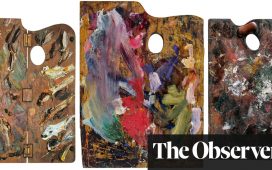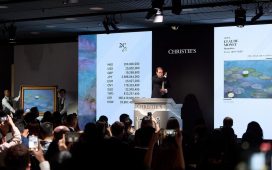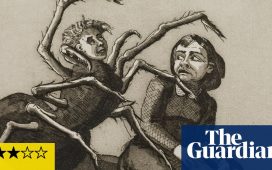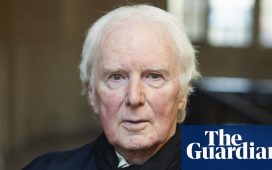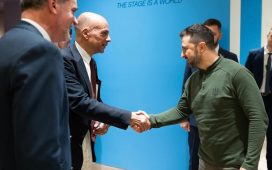In 1930 the London Group of artists staged an open-air sculpture show on the roof garden of Selfridges department store in the city’s Oxford Street, featuring the work of established names such as Jacob Epstein and Frank Dobson and rising stars including Henry Moore, Barbara Hepworth and John Skeaping.
Ninety-four years on, the store has become the grande dame of London’s main shopping street, an architectural landmark with its giant-order fluted columns (it was one of the first steel-framed buildings in the city when it opened in 1909) and periodically a site for artist exhibitions and interventions. (In 2017 the US artist Miranda July turned a corner of the shop into a multifaith charity shop for an Artangel commission.) This month, for just over three weeks, four artists—Rana Begum, Jason Bruges, James Righton and Damien Hirst—are presenting work in the store’s street-front windows in response to pieces produced by the New York jeweller Tiffany & Co. (An estimated 130,000 people walk past the front of the store each day.)
Tiffany & Co has a long history of both technical innovation and collaboration with artists. It was founded in 1837 by Charles Lewis Tiffany, and from 1902 boasted Louis Comfort Tiffany—the founder’s artist son who built his own brand in Tiffany Studios stained glass, lamps and enamelware before joining his late father’s company—as its chief designer. Between 1956 and 1958 the company’s window designer Gene Moore employed the young Robert Rauschenberg and Jasper Johns to create Surrealist backdrops for the windows of its Fifth Avenue store in Manhattan. Soon after, the company commissioned a series of holiday greeting cards from Andy Warhol at the time of the Pittsburgh-born provocateur’s transition from fashionable graphic designer to globally feted fine artist. The work of Moore, Rauschenberg and Johns is referenced in some of the multiple displays in the Windows of Wonder show at Selfridges, which marks the opening of a Tiffany shop in the department store and runs until 20 October.
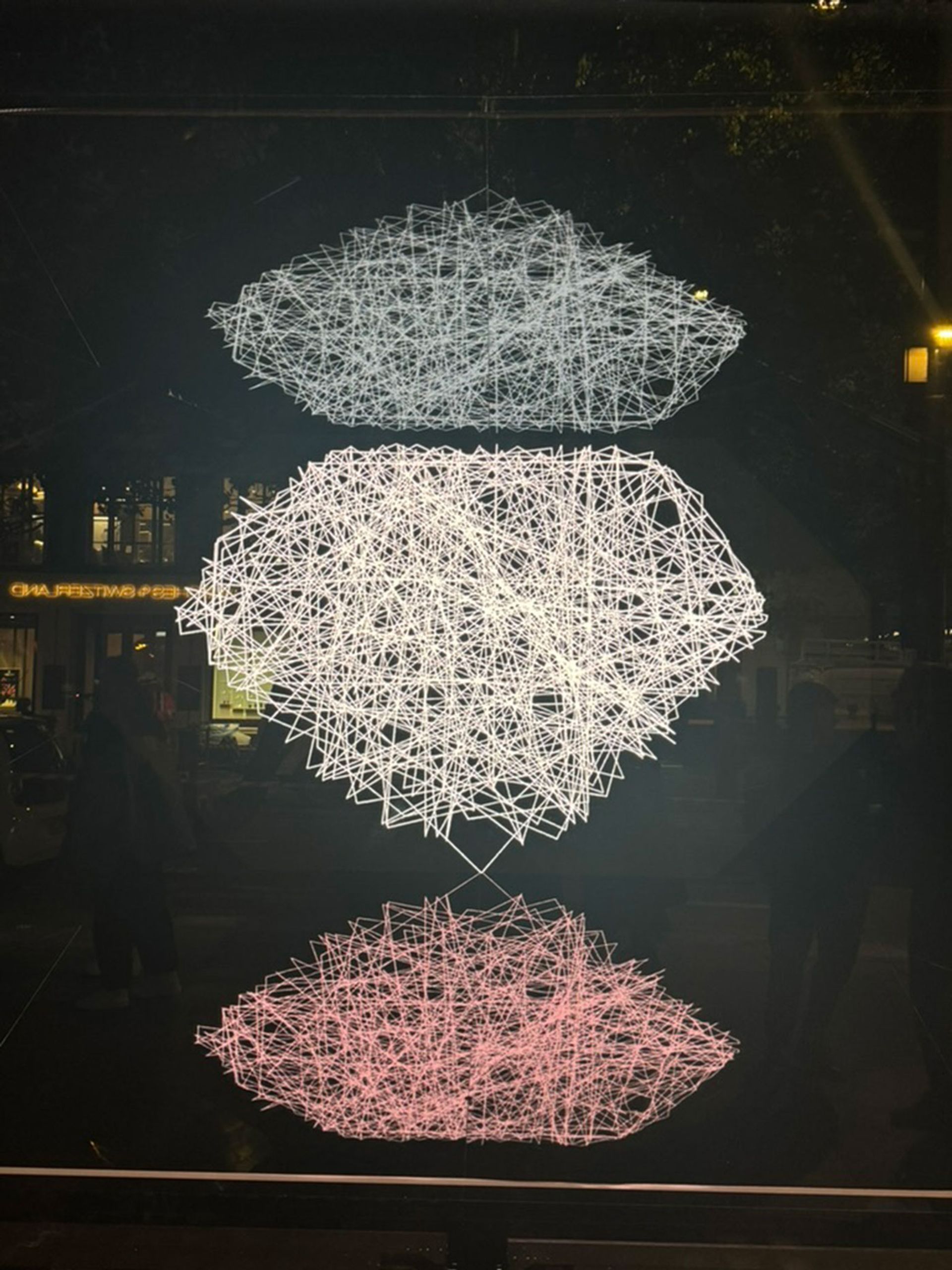
Jason Bruges, Light Loci 1.0 (2024), Selfridges, Oxford Street, London Courtesy: Jason Bruges Studio
Tiffany and Selfridges both have a history of innovation in marketing and branding. The Wisconsin-born Harry Gordon Selfridge let the world know that his London store, intended to rival the great emporia of Chicago and Paris, was designed to be a pleasure to visit, a place to linger—the saying “the customer is always right” has been attributed to him—while Charles Lewis Tiffany devised the Blue Book catalogue as a mailed-out publication to spread the Tiffany word. The robin’s egg blue of the catalogue cover became the company’s brand and packaging colour and was registered as Pantone 1837, to commemorate the year of the company’s founding, in the Pantone colour library.
The scale and variety of Tiffany & Co’s archive was revealed in an exhibition, Vision & Virtuosity, that had iterations in Shanghai in 2019 and at the Saatchi Gallery in London in 2022. It is well known that Tiffany has made celebrated US sporting trophies including those for the US Open tennis championships, for both men and women, for the Super Bowl and for two legs of flat horseracing’s triple crown, the Preakness Stakes and the Belmont Stakes. What is less well-known is the sporting performance breakthrough that Tiffany enabled when they made the first set of lightweight aluminium racing plates in the 1870s for the New York tycoon Pierre Lorillard—the leading racehorse owner of his day on both sides of the Atlantic and the first American owner to win the Epsom Derby, in 1881.
Lorillard was one of many New York art collectors, along with members of the Morgan banking dynasty, who were regular clients of Tiffany & Co—the company was dubbed, from the 1840s onward, the “diamond kings” of Manhattan. The Tiffany collection today includes the celebrated inch-wide 128.54-carat Tiffany Diamond, a yellow stone acquired by the company’s founder in 1878, the year after its discovery in South Africa, and the 80-carat Empire Diamond.
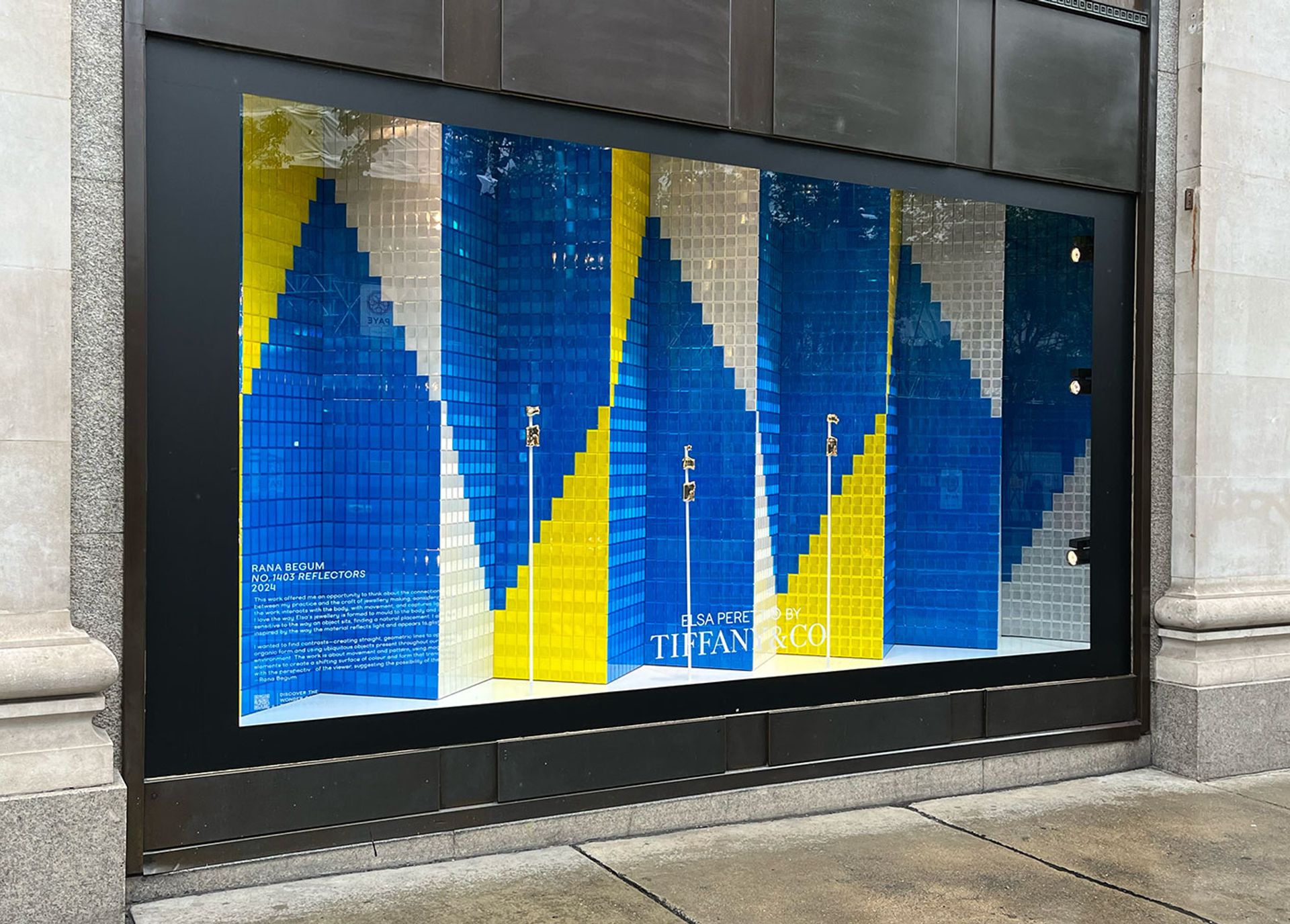
Rana Begum, No 1403 Reflectors (2024), with, in the foreground, three Bone Cuff bracelets, a design created in 1970 for Tiffany by Elsa Peretti. An installation for Windows of Wonder at Selfridges, Oxford Street, London The Art Newspaper
The sculptor and painter Rana Begum—an artist with a varied practice that almost defies categorisation but whose best-known Louvre and Mesh pieces achieve an impression of near weightlessness—has made an installation, No 1403 Reflectors (2024), with straight lines and bold colours that complement the organic shape of the golden wrist-hugging Bone Cuff bracelet. The Bone Cuff, a ground-breaking piece moulded for Tiffany in 1970 by the widely admired designer and conservationist Elsa Peretti, has long since become a staple of design museum collections.
Jason Bruges has used a Tiffany cushion-cut diamond—a square-cut gem with round corners in the manner of the Tiffany Diamond itself—as inspiration for his Light Loci 1.0 (2024), a new algorithmically powered light sculpture that explores the experience of “inhabiting” a diamond. The sculpture builds in mesmeric fashion from a simple polygon of a few generative beams of light to an ever-more complex, multi-edged mesh, simulating how light travels through the diamond’s interior.
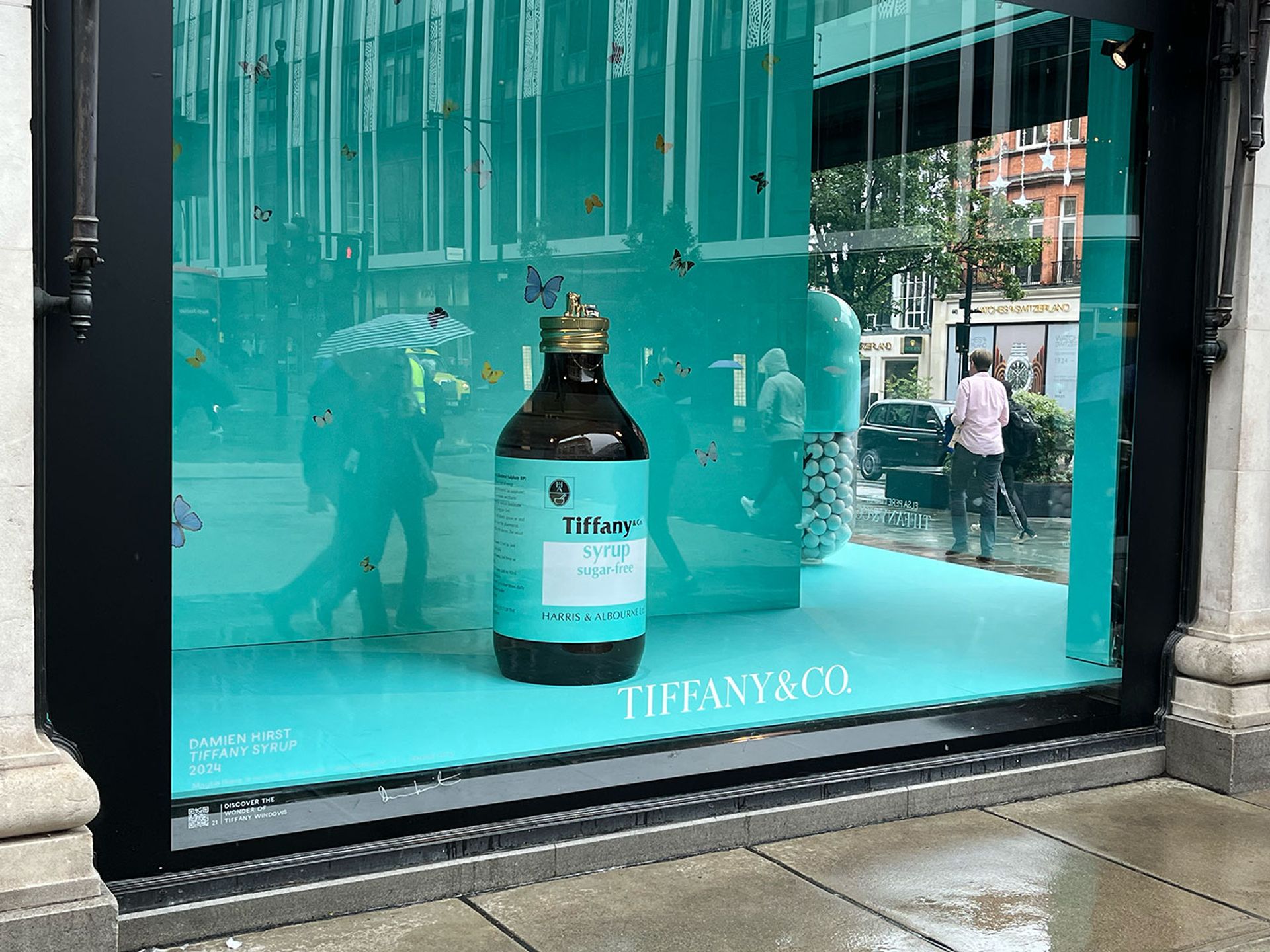
Damien Hirst, Tiffany Syrup (2024), Selfridges, Oxford Street, London The Art Newspaper
The 1837 Pantone blue is a framing pigment for many of the storefront windows and is strongly referenced by Damien Hirst and James Righton. In a corner site Hirst has placed Tiffany & Co, 300mg, HST, 1837 (2024) and Tiffany Syrup (2024): two works based on oversized medicine bottles, with a clear reference to Hirst’s early Pharmacy series, while one of the artist’s more recent motifs, the butterfly, appears on the window’s back walls.
The musician Righton deploys fluctuating, undulating, layers of gradually enlarged circles in his installation, Untitled (2024), powered by a system of motors to match with the pulsating musical piece he has provided for the display. “I was inspired by the cyclical nature of life,” Righton writes in a caption to his work. “Our experiences, from the natural world to human existence repeat but are never the same. I wanted Untitled to represent this … The human and natural elements of the pianos work alongside the more contemporary sounds of the synthesiser. The drum is the human heartbeat. By the end of the piece I want the listener to feel like they’ve been on a journey.”
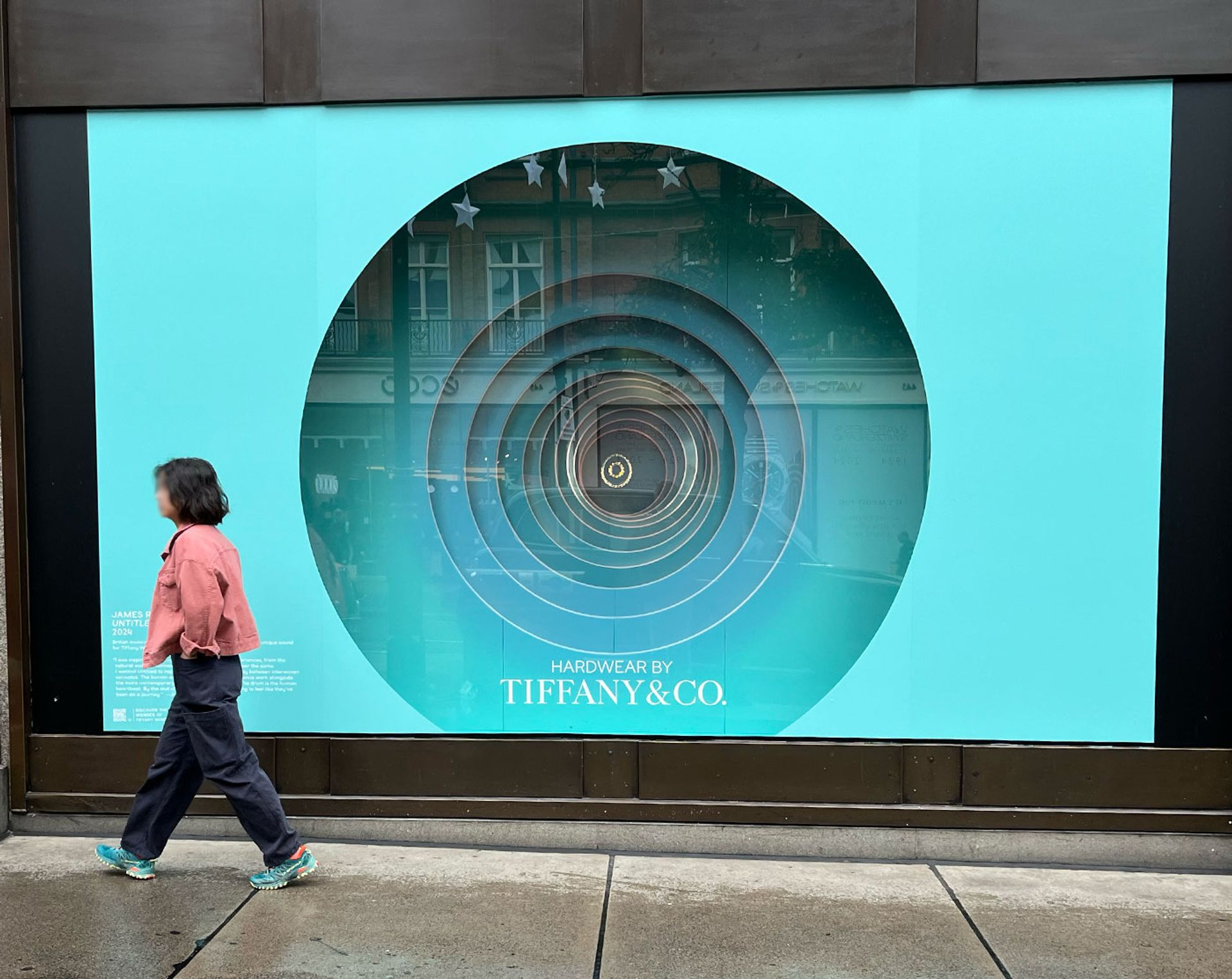
James Righton, Untitled (2024). Installation for Windows of Wonder at Selfridges, Oxford Street, London The Art Newspaper
Two years’ work on the inside of a diamond
Bruges, who has become established in recent decades as a leading media artist working algorithmically with light, tells The Art Newspaper that his Light Loci 1.0 has been worked on for two years by the team of 25 coders, computational designers, engineers, visualisers and 3D artists that work in his east London studio.
“My pitch,” he says, “was the idea of imagining a journey through a diamond—imagining you’re a photon travelling through a diamond and what path that would actually create and looking at the total internal reflection, building up an imagined space. We’ve been working on various versions of that, in collaboration with Tiffany. So it’s like work in progress. And we’ve been doing a whole series of experiments. Hence the name Light Loci: a locus is a path generated according to a rule system. This rule system is the property of the diamond itself.”
Bruges trained as a creative, a physicist and an architect—he worked for a time at Foster + Partners and still collaborates regularly with that architectural practice—and is best know for his architectural-scale installations in London—in the Octagon Hall at Tate Britain, in the Barbican underpass and the route to Wembley stadium—and across the globe. Bruges says he has been inspired by light artists of older generations including Dan Flavin, James Turrell and Jim Campbell. He also much admires Olafur Eliasson‘s work with fountains.
Jason Bruges Studio created The Constant Gardeners for Tokyo Tokyo Festival Special 13 part of the 2021 Olympiad. There, four robot arms, each weighing more than a tonne, were used to rake and draw in a bed of gravel: in response to the Olympic sporting events of the day. It was a no less ambitious collaboration—Dichroic Blossom (2014)—with Foster + Partners in Beijing, Bruges thinks, that caught the eye of the Tiffany creative directors.
Dichroic Blossom—a dichroic material is one that splits light into distinct beams of different wavelengths or colours—is an interactive wall designed to change appearance according to different seasons and different times of the day, and interactively with people walking through the space. It delivers an interpretation of a Chinese plum blossom, a constituent part of Chinese art and poetry for centuries. The blossom is a form that was used by Louis Comfort Tiffany in his own Tiffany Studios designs, including his patterned glass lamps. He brought that feel for the organic, for natural form, with him, in the shape of artistic jewellery designs using metalwork, enamel and semi-precious stones, once he became chief designer of Tiffany & Co, his father’s old firm.
Many of Bruges’s latest projects are concerned with the elements and with natural forms. “I’m working in a world inspired by physics, but also by the natural world … on a piece that’s about optics and water movement in New Jersey,” he says, “and on a piece about cloud formations at Tampa International Airport.” The studio relatively recently completed a piece for Boston Children’s Hospital, which examined how plants grow and branch, much in the manner of Dichroic Blossom.
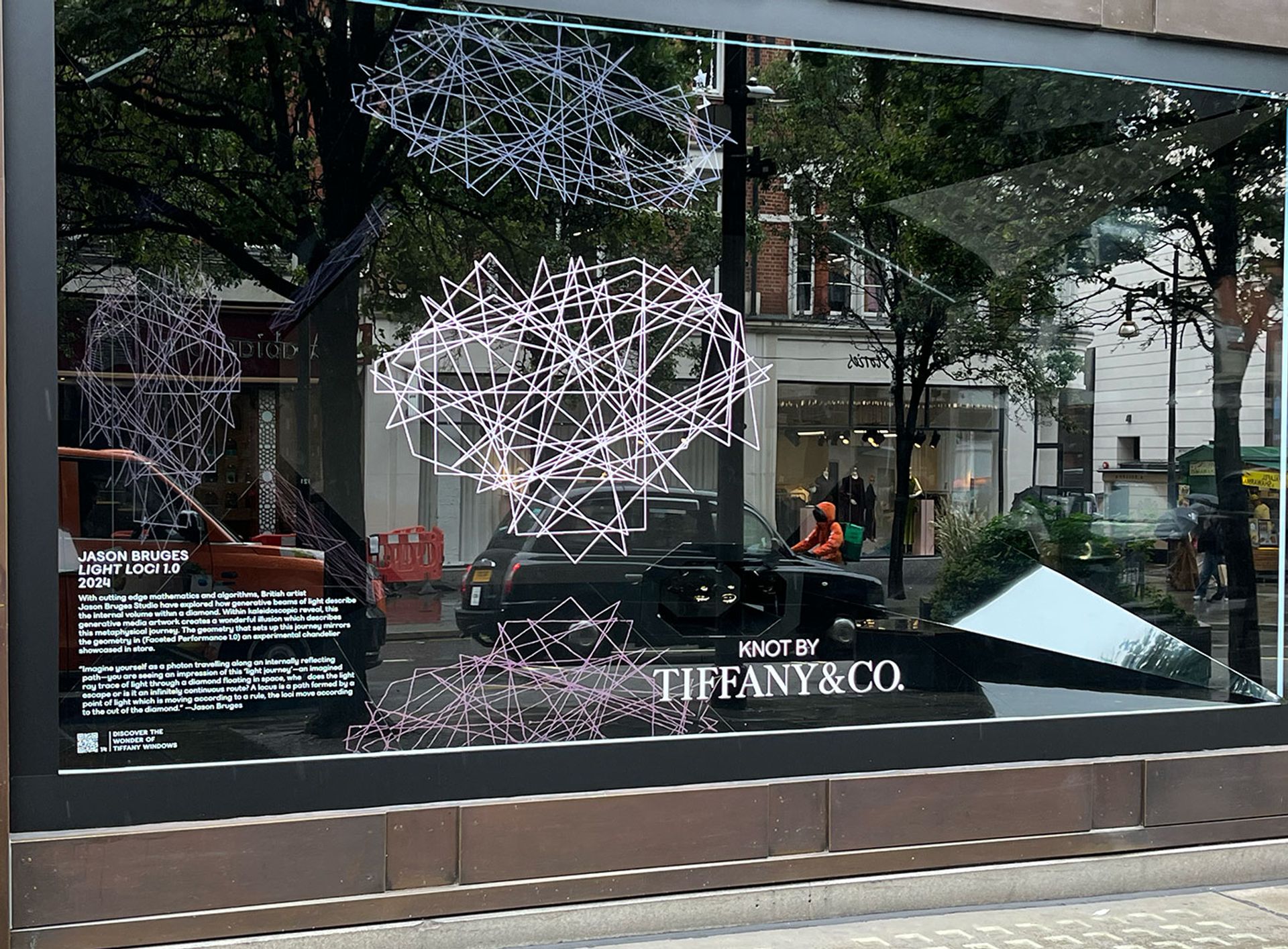
Jason Bruges, Light Loci 1.0 (2024), Selfridges, Oxford Street, London The Art Newspaper
Working with Tiffany, Bruges says, has impressed on him the immense number of specialist crafts—much as in the making of a film—that are required to create their jewellery. And he cherished the moments, he said, of working with the company—”commissioners that have extraordinary history and are properly invested in creative process and in being patrons of the arts and of creative endeavours”. There is an interest in innovation and new technologies and new processes, in this collaboration, he says, where that innovative approach is “colliding really interestingly and nicely, with tradition and wonderful crafts.” He adds: “Hopefully it’s a new way of looking at it. It doesn’t ignore the history, the provenance and the craft, but builds on it. And it says, ‘Look, we’re in an extraordinary time where we can imagine things in a different way, we can build things in a different way, and we can inspire and create magic in new ways.'”
When working on Light Loci 1.0, Bruges says, he was concerned as much as ever with natural forms: “My interest is in visualising the invisible and particularly the kind of science, rule systems and algorithms that underpin our natural world and its processes.” The diamond, he says, “is a code, it’s an instruction set for lights. It’s a punch card, it’s a line of code, it’s almost like DNA for light, it instructs the light what to do. And I think that’s probably the thing I’m interested in most of all.”
- Windows of Wonder, Selfridges, Oxford Street, London, until 20 October. Guided tours from Duke Street entrance on Saturday 28 September, 11am to 6pm, no booking required.
